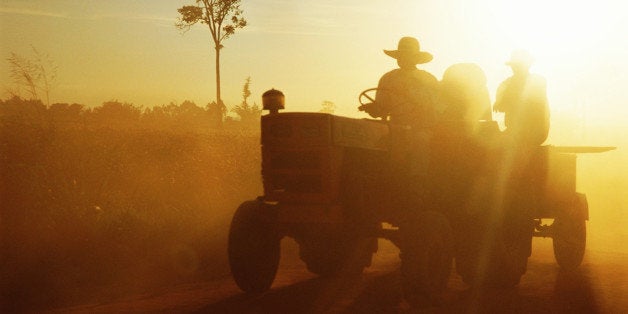
If you have ever been to St. Charles, Michigan, you know how small of a town it is. Not the smallest in the world, no, but definitely small. Smaller. Small-ish. It's a blink-and-you'll-miss-it-type of town, but not in a bad way; just a "these are the facts" kind of way. You drive-through it-to-get-to-the-state capital-kind of way.
It's a town with one stoplight. Three main roads. Restaurants that look like taxidermies, with duck and deer and moose and geese on the walls. Jukeboxes in the corners, pictures of the '99 State Championship football team hanging at a slant, showing tinged wallpaper from cigarettes and smoke. We got a Subway when I was in high school, which was a highlight of my small life back then. My senior class song was Mellencamp's "Small Town."
Near the high school, there's a road leading to the football stadium that might as well be the paved path to the pearly gates. Football is a form of worship here, with the lights and the field and the sky. Bleachers are the pews, the town coming together as a collective red, black and white "Go Bulldogs" group sitting on the silver metal, the constant sound of the "clang, clang, clang" as others walk up the steps.
There are thousands of towns across the country like this one. I grew up here.
I didn't know my hometown was a small town. Not really. Not until college, anyway. That's where I realized not everyone gets stuck behind turbines and farm equipment on their dirt road. Not all people hear cows mooing at night. In turn, I didn't realize Tiffany's jewelry is not just for celebrities and people graduate with classes bigger than 80 students. It doesn't take everyone at least 15 minutes to get anywhere that's somewhere.
As a teenager, I wanted nothing more than to leave. To get the heck out. To drive far away from the Small, allured by the Big, the Flashy, the Bright and the Bustling. The City. I had my heart set on New York City. Chicago would do, I supposed, but I wanted skyscrapers and glossy magazines and editors and subways. As a freshman in college, I applied to magazines. I didn't get the internships. At the time, I was frustrated, angry, upset, but in the end, it all works out the way it's supposed to.
It all does.
Because I realize now that where we grow up, where we're from, how we live in those formative years becomes the perimeter in which you base your life around. You can reject it and leave, or accept it and stay. Neither is better or worse. It's just a choice. Even if you want different, even if you leave and prove the saying right, the one that's all "You can never go home again," even if you wanted to leave the town or the city and the people and the memories, it's still a part of you, whether your hometown is a small town or a big city.
My perspective is probably biased, but it seems when you're from a small town, the breadth is smaller, the depth deeper. The fabric is woven just a bit tighter in your life's tapestry because it wasn't just where you lived, it was the knowledge that came with it. You knew who lived where and who's dating who and what's what. There's a bonding there because of the proximity. Big fish in small ponds. Then the question becomes: Do you want to swim here or move on to a bigger pond? A lake? An ocean? Either way, you can't erase the waters you first swam in.
We all have our past that becomes a part of our present. The things that happen behind high school walls and on gymnasium floors, in the backs of cars and beyond the burnings of a bonfire, it affects us and how we choose to live after the fact. Where we grow is just as important as how we grow. The deepness of a tree's roots depends on the soil.
When I was in elementary school, my daycare provider lived across the street from the football stadium. One day, I was allowed to walk halfway up the road towards the football field, past the bus garage and turn around when I reached the gate near the softball field. I felt brave and independent, until I looked down at the concrete and saw giant paw prints. Alternating red, black, red, black paws stretched out in a line down the road before me.
A monster has been here, I thought, feeling the fear turn my legs to jelly. I have to turn back. NOW. I ran as quickly as I could back to my daycare provider, hurriedly explaining my fears about the monster and what I saw. She assured me that no, there was no monster, the cheerleaders had recently painted those paw prints because they represent our bulldog mascot.
Whatever, I thought. I don't care. There WAS a monster.
Now, these memories stay with me. Who I was when I lived in that small town stays with me. Who I wasn't stays with me, too -- how I've changed and grown from that girl scared of the monster on the paved path. A part of me will always be that little girl. I will always be grateful for growing up in a small Midwest town with deer heads and cow fields and dirt roads because that is engrained in me. That's part of my history.
We all have our histories. Histories that may create scripts and sadness and expectations. Histories that haunt, or beg to be forgotten about, or linger in our minds with fondness and appreciation. Regardless, our histories make us who we are. We may not be who we were when we lived in this city or that apartment or on that street. But it's a part of us. That version of us, and that version, and that version.
And when we feel lost or can't find ourselves or don't know who we are anymore, maybe it's good to go back. Even for a day. Maybe, just maybe, sometimes it is good to go home again. Once in a while, anyway. Just to remember who you were in order to see who you are now.
Go back to where the monsters are, and maybe you'll learn they're just paw prints and paint.
